Understanding the Context Menu
Context menus with specific content are displayed for different nodes in the Omni Designer Project Explorer, depending on whether the project has been shared, and the specific item or multiple items that have been selected.
Context Menu Options for a New Project
The context menu for the created (not shared and not checked out) Omni Designer Project has the following options:
- Share. A project can be shared with the localhost
server or another server so users can make a copy (check out project)
and work with that copy at their own computer.
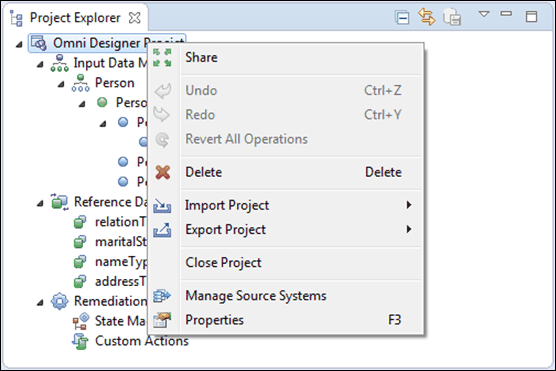
After you select the Share option, you will be asked to select a server to host the share, as shown in the following image.
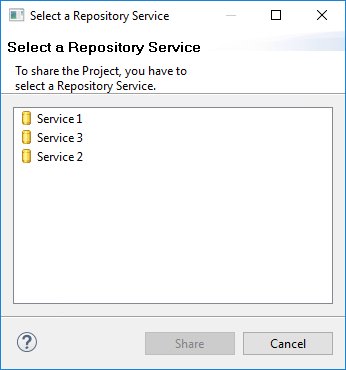
To share a project, select a server and click OK. If you are not logged in to this server, an additional dialog message to log in appears.
If you are logged in, a confirmation dialog appears.

The project is then shared with the selected server and appears in the Repository browser.
The following image shows the context menu for a closed Omni Designer project.
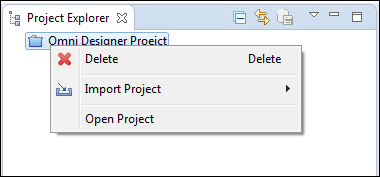
- Undo. The last change that was made in a project (after
the last commit or sharing) can be canceled using this option or
by pressing Ctrl+Z. A corresponding option from the Eclipse menu
can also be used for this.
Once the project is committed or shared, changes cannot be canceled. If changes were not made (for example, new Project), then the Undo option is disabled.
- Redo. The last change that was undone using the Undo option
in a project (after the last commit or sharing), can be returned
using this option or by pressing Ctrl+Y. A corresponding option
from the Eclipse menu also can be used for this.
If changes were not undone, the Redo option is disabled.
- Revert All Operations. All changes that were made in
a project (after the last commit or sharing) can be canceled using
this option. Once the project is committed or shared, changes cannot
be canceled. If changes were not made, then the Revert All Operations option
is disabled.
After selecting this option, a confirmation message appears, as shown in the following image.

- Delete. This option removes a project and all of its
content from the Omni Designer Project Explorer. After selecting this option,
a confirmation message appears, as shown in the following image.

- Export project. This option is used to export a project
in an XMI file. The following dialog appears:
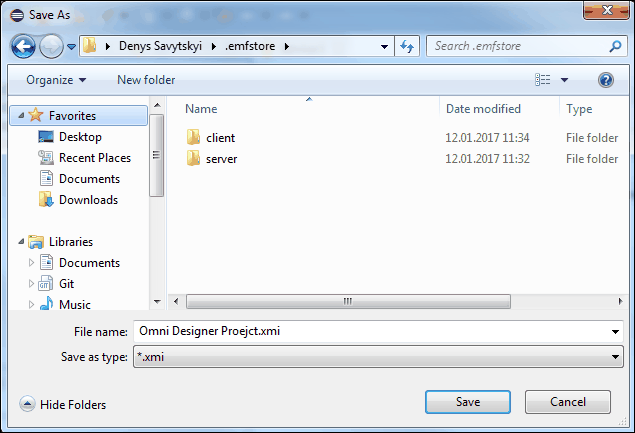
The project name is predefined in the file name field. The At (@) character and version were added for shared or checked out projects. The XMI extension is set by default and cannot be changed.
To export a project, select a location to save the file, update the filename, and click Save.
A confirmation message appears, as shown in the following image.

The XMI file is saved in a selected location and can be imported to the Omni Designer Project Explorer by any user.
- Import project from XMI File. This option is used to import a project
from an XMI file to the Omni Designer Project Explorer. The following dialog
appears:
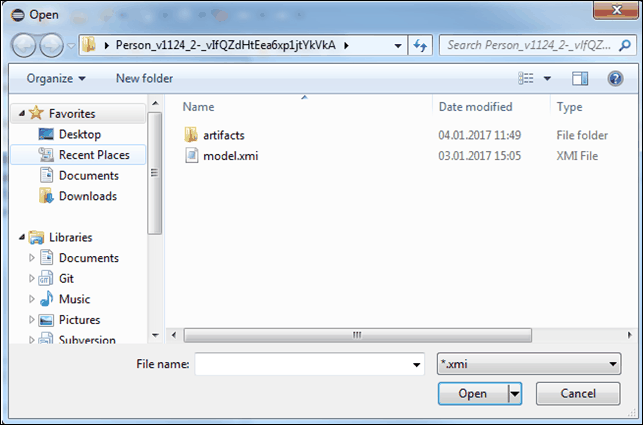
Select the XMI file with the exported project and click Open. The Omni Designer Project window appears, as shown in the following image.

The name of the exported project is predefined in the Project name field. The At (@) character and version were added for shared or checked out projects. You can change and add any description you wish, then click Finish.
The following confirmation message appears.

The project is imported to the Omni Designer Project Explorer. The whole project structure and data are recovered. Imported projects can be used as any created project.
- Import project from XMI/UML Data Model. This option is used to import projects from the XMI/UML data model to Omni Designer. The following dialog shows the imported
Omni Designer project.
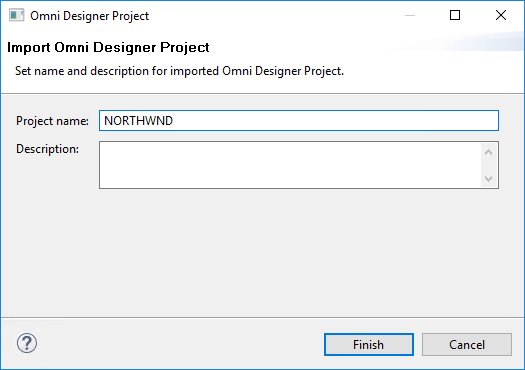
- Import project from Release Bundle. This option is used to import projects from a Repository Service.
When you select this option, you will need to select a Repository Service, as shown in the following image.
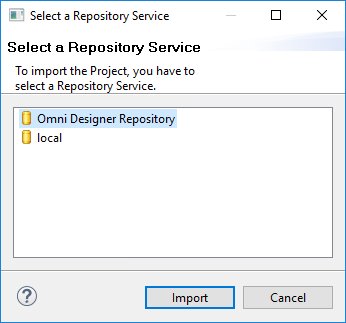
After you click Import, navigate to and select the bundle and click Open.
- Close project. This option is used to close the project
(archive). If the project has some validation errors, they will
disappear from the Problems tab after closing the project. The errors
will reappear in the Problems tab after opening the project again.
Once the Omni Designer project is closed and all of its panels are hidden, they will be available again after reopening the Omni Designer project. The Properties tab for the closed project contains the information section with the non-editable Name and Description fields of the project. A closed project can be deleted or opened.
- Manage Source Systems. This option is used for managing source systems. It will open Project Properties (Project Editor) on the Source Systems tab.
- Properties. This option will open Project Properties (Project Editor) on the General tab. Properties can also be opened by pressing the F3 key. Project Properties (Project Editor) also contains Source Systems and Release Management tabs.
Context Menu Options for a Shared Project
The following list describes the context menu options for shared projects.
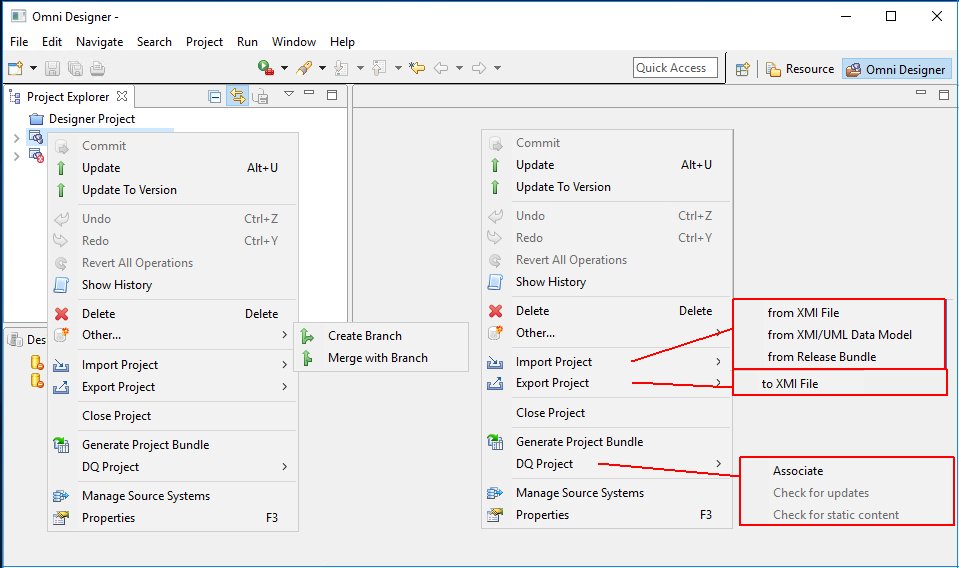
- Commit. This option is enabled and can be performed
for saving changes you made with a project (for example, Create,
Rename, and Delete subjects or Input Data Models). Once changes are
made, a committed version of the project is updated and displayed
near the Project name in the Omni Designer Project Explorer. After additional
commits, the version is automatically increased. If no changes were
made, then the Commit option is disabled.
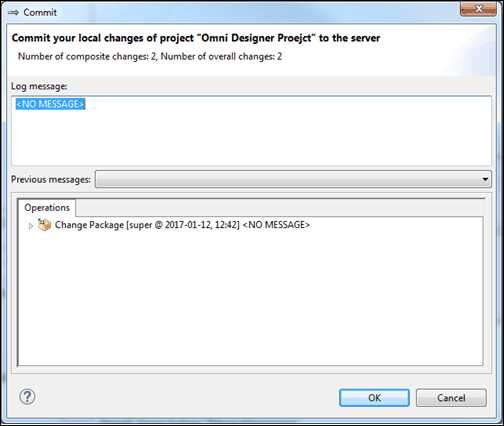
- Update. This option is used for updating a project and
synchronizing it to the latest version. For example, if there are
several users working on the same project (one is a shared project
and the other is checked out), and a user made and committed changes
to the shared project, clicking Update will update the checked
out version.
The Update window appears, as shown in the following image.

To update the project, select a version and click OK.
- Update To Version. Similar to Update, this version
updates multiple shared project versions and prompts you to select
which version you would like your project updated to.
After selecting Update To Version, the following window appears.

Select a version to update your project to and click OK.
- Create Branch. This option creates a new branch for the
current project and provides possibilities to make different changes
in a separate branch. If no changes were made, then the Create
Branch option is disabled.
After selecting this option, the Create Branch window appears, as shown in the following image.
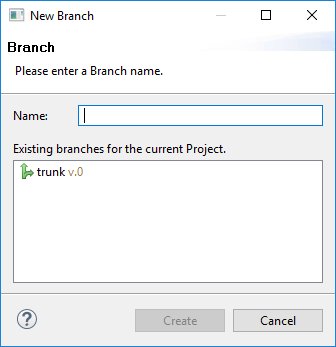
Enter a new branch name in the Name field and click OK.
- Merge with Branch. This option merges (incorporates)
the version of your project with the created branch and combines
your project with changes made in the branch. If no changes were
made, then the Merge with Branch option is disabled.
After selecting Merge with Branch, the Branch Selection window appears, as shown in the following image.
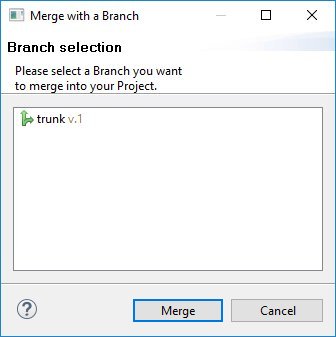
To merge with a branch, select a branch from the list and click OK.
- Show History. This option opens the History browser tab
at the bottom of Eclipse and displays all changes regarding new
versions or branches, as shown in the following image.
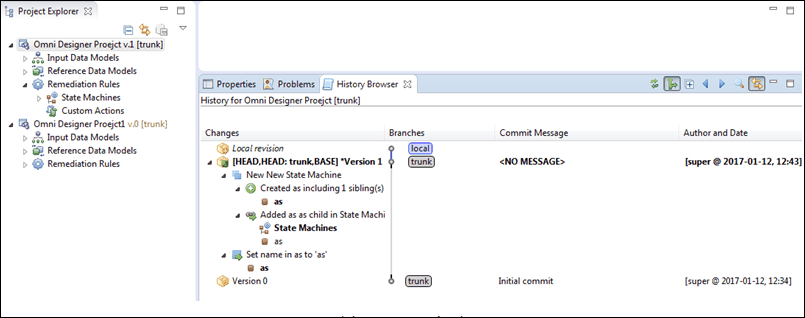
- Generate Project Bundle. This option opens a dialog to release a project. For more information, see Using the Repository Browser.
- Associate. This option opens the Associate with DQ Project option allowing you to associate Omni Designer projects with an available DQ Project. For more information, see Associating Omni Designer Projects With Data Quality Projects.
- Check for Updates. This option verifies an associated DQ Project for updates on the development server. This option is disabled if the Omni Designer project is not associated with a DQ Project, and becomes enabled for an associated Omni Designer Project. For more information, see Associating Omni Designer Projects With Data Quality Projects.
- Check for Static Content. This option verifies an associated DQ Project on the Repository service for existing (or non-existing) static content (for example, a folder containing cleansing, matching, merging, or remediation content). This option is disabled if the Omni Designer Project is not associated with the DQ Project, and became enabled for the associated Omni Designer project. For more information, see Associating Omni Designer Projects With Data Quality Projects.
Other options from the context menu for shared projects (for example, Undo, Revert All Operations, and Delete) work in the same way as projects that are not shared.
Context Menu Options for the Input Data Models Node
The following image shows the context menu for the Input Data Models node.
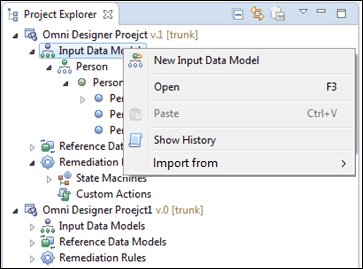
The following list describes the context menu options.
- Input Data Model. This option is used for creating new Input Data Models for the current project.
- Open. This option is used to open the Input Data Models editor to function with dimensions and measures.
- Paste. This option is used for pasting previously copied
input data models into the input data models of the current project.
You can paste input data models copied from the same project, as
well as those copied from a different project.
The Paste option is disabled if there are no copied or cut input data models in the clipboard. The Ctrl+V key button or the corresponding option from the Eclipse menu can also be used for the Paste option as well.
- Show History. The Show History option works in the same way that is listed in context menu for the shared Omni Designer project. The option is available only if the project is shared.
- Import from CVS. This option enables you to create an Input Data Model by importing a CVS file. When you select this option, the Select Data
Source dialog box opens, as shown in the following image.
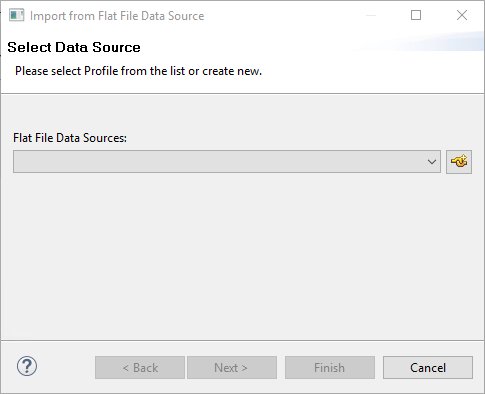
You can select a flat file from the list, or create one by clicking the Create new Flat File Data Source. The Create Connection Profile dialog box opens, as shown in the following image.
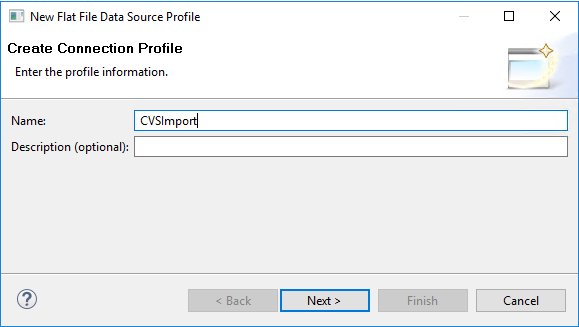
Enter a name for the connection profile and click Next. The Define Folder or a File URI dialog box opens, as shown in the following image.

Select a home folder or enter a file URI and click Finish to import the CVS as a Input Data Model.
Context Menu Options for Specific Input Data Models
The following list describes the Input Data Models.
- Open. The input data model and other subjects can be opened in the editor using either the Open option from the context menu, the F3 key on your keyboard, or by double-clicking the requested input data model or subject.
- Rename. The input data model can be renamed in line using
this option or by pressing the F2 key on your keyboard. If you rename
the input data model, then the root subject will be also be renamed
to the same name.
You can rename the item you wish and then press the enter key. The name of input data model is changed.
- Cut. The cut option copies the input data model with
all subjects and simultaneously removes it without confirmation.
You can also press Ctrl+X on your keyboard or select the corresponding option from the Eclipse menu.
- Copy. The Copy option copies input data models with all
subjects.
You can also press Ctrl+C on your keyboard or select the corresponding option from the Eclipse menu.
- Delete. The Delete option removes the input data model
with all subjects without confirmation.
You can also press the Delete key on your keyboard or select the corresponding option from the Eclipse menu.
- Show History. The Show History option works the same way as listed in the context menu for the shared Omni Designer project. This option is available only if the project is shared.

Context Menu Options for a Subject
The context menu of the root subject and regular subject are identical.
The following image shows the context menu options for a root subject.
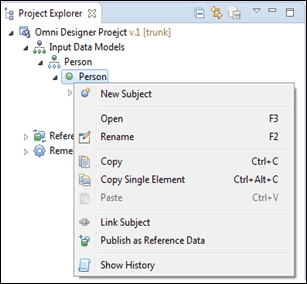
The following image shows the context menu for a regular subject.
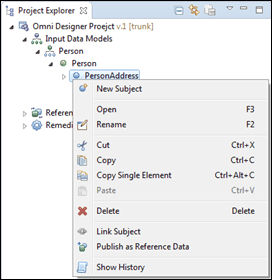
Notice that the context menu for the root subject does not contain the Cut and Delete options.
The following list describes the context menu of the subject.
- New Subject. The Subject option is used for creating a new child subject for the selected parent subject.
- Open. The subject can be opened in an editor using the Open option from context menu, the F3 key, or by double-clicking the required subject you wish.
- Rename. The subject can be renamed in line using this
option or by pressing F2. If you rename the root subject, then the
parent Input Data Model will be also renamed to the same name. After
selecting this option, the cursor will be set in the field of the
selected item.
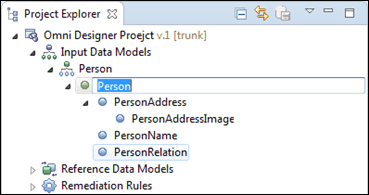
After renaming an item, press Enter.
The name of the subject is changed.
- Cut. The Cut option copies and deletes the subject with
all child subjects (if any) and simultaneously moves them to the
Clipboard. This option is disabled for the root subject.
You can also press Ctrl+X or select the corresponding option from the Eclipse menu.
- Copy. The Copy option copies the subject with all child
subjects (if any).
You can also press Ctrl+C or select the corresponding option from the Eclipse menu.
- Copy Single Element. This option copies the subject without
any child subjects (if any).
You can also press Ctrl+Alt+C as an alternative.
- Paste. The Paste option is used for pasting previously
copied subjects (with or without child subjects) to the current
subject. You can paste subjects copied within the same Input Data
Model and project, as well as those copied outside of the current
Input Data Model and current Project.
Previously copied root subjects can be pasted as a regular subject.
The Paste option is disabled if there are no copied or cut subjects in the Clipboard. You can also press Ctrl+V or select the corresponding option from the Eclipse menu.
After pasting the subject to another Input Data Model, fields with Reference and Inherited data types are updated. The Reference values are changed to empty.
- Delete. The Delete option deletes the subject(s) from
the project. This option is not available for the root subject.
You can also press the Delete key or select the corresponding option from the Eclipse menu.
- Link Subject.This option is used to link other subjects with all their children subjects as a local subject (restricted copy). The option is available for any subject including a root subject.
- Publish as Reference Data. This option is used to publish the subject with all of its child subjects
as the Dynamic Reference Data. The option is available for any subject
including root subjects.
The Delete key and the corresponding option from the Eclipse menu can be used for the Copy option as well.
- Show History. This option works the same way as mentioned in the context menu for shared Omni Designer projects.
Context Menu Options for Reference Data Models
|
Topics: |
You can select the following options from the context menu for Reference Data Models:
- New Static Reference Data. This option is used for creating new static reference data for the current project.
- Paste. The Paste option is used for pasting a previously
copied Reference Data Model to the Reference Data Models of the
current project. You can paste a Reference Data Model that is copied
from the same project or that is copied from another project.
Note: The Paste option is disabled if there is no copied/cut Reference Data Model in the clipboard. You can also press Ctrl+V as a shortcut or select Paste from the Eclipse menu.
- Show History. The Show History option performs the same way as mentioned in the context menu for a shared Omni Designer project. This option is available only if a project is shared.
Pasting Static Reference Data
After selecting Paste, the Paste Static Reference Data window appears If reference data was copied or cut from a project with at least one source system. The Manage Source System dialog manages moving source system values.
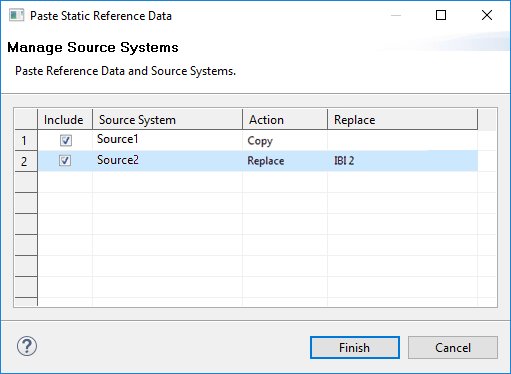
The following table describes the column parameters for Paste Static Reference Data.
|
Parameter |
Description |
|---|---|
|
Include |
Select the check box if you want to keep values of the source system in a project where you are pasting reference data. By default, the check box is cleared if there are no values of this source system in the current reference data. However, it is selected by default if there are any values of this source system in the current reference data. If you clear the check box for the source system that has values, the following message appears at the top of the window: Values of excluded source systems will be lost in target location. If the check box is not cleared, the whole row will be disabled. |
|
Source System |
Name of source system project where you used the Cut command or copied the current reference data from. |
|
Action |
Contains a drop-down list with the following two options to choose from.
|
|
Replace |
Contains a drop-down list of source systems available in the project where you pasted reference data. The Replace option is enabled only if you select the Replace option from the drop-down list of the Action column. |
The Finish button is disabled if there is at least one row with the Include check box selected without an Action option, or the Replace option selected with no source system for replacement. In both cases, the appropriate cells are marked with validation icons and the following warning message appears at the top of the window: All required values must be set.
If reference data was copied or cut from a project without any source systems, then the current dialog does not appear.
Pasting multiple static reference data is allowed only for Static Reference Data from the same Project.
Pasting Dynamic Reference Data
This section contains the following options for selection:

- Link to existing Subject. This option allows you to link Dynamic Reference Data to another Subject without copying either
the source Input Data Model or Subject.
After selecting this option, click Next, and then a list of Subjects with names similar to the source Subject appears, as shown in the following image.
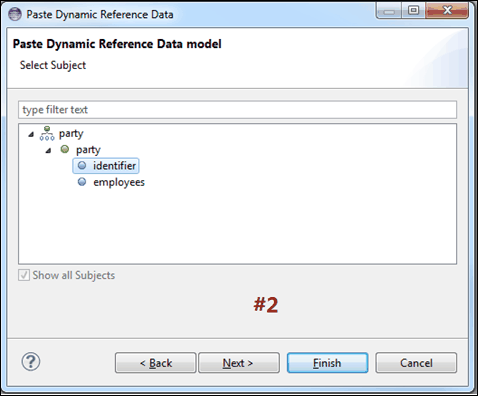
You can see all existing Subjects in the target Project Input Data Models and Subjects by selecting the Show all Subjects check box. The Search field becomes enabled where can find any Subject by name.
After selecting a Subject, click Next to change the Reference Data for matching.
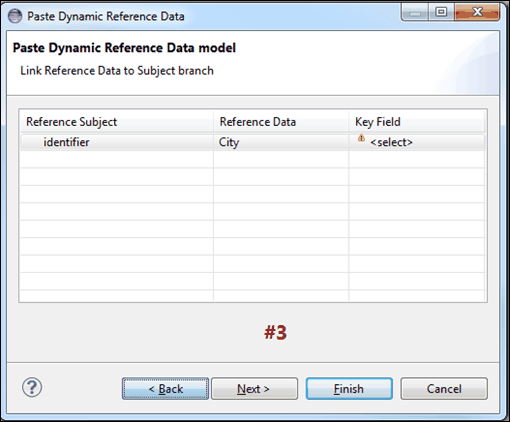
The following table lists and describes the column parameters.
Parameter
Description
Reference Subject
Displays a list of subjects for specific selected parent subjects from the previous step.
Reference Data
Reference Data which is being pasted.
Key Field
Field which will be set as a key field in the new pasted Dynamic Reference Data Model.
Mappings from the Reference Data column will be copied to the corresponding Reference Subject. Reference Data values, which are not set, will be lost and new ones will be created instead.
You can also set Key Field on the same Wizard (The Finish button is enabled whether Key Field is set or not).
The link to the existing Subject Dynamic Reference Data will appear after clicking Finish.
- Copy entire Input Data Model. This option allows you to copy Dynamic Reference Data with an entire Input Data
Model whether or not the root or child subject was published.
After selecting this option, click Next, which will then allow you to change the Reference Data for matching (Reference Data and Key Field columns are set automatically with source values).
Mappings from the Reference Data column will be copied to the corresponding Reference Subject. Reference Data values, which are not set, will be lost and new ones will be created instead.
Using the same Wizard, you can set the Key Field (the Finish button is enabled regardless if Key Field is set or not).
The Dynamic Reference Data will appear in the target project after clicking Finish, and a new Input Data Model will be created.
- Create new Data Model from Subject branch. This option allows you to copy Dynamic Reference Data and
create a new Input Data Model from the Subject branch.
After selecting this option, click Next, which will then allow you to change the Reference Data for matching (Reference Data and Key Field columns are set automatically with source values).
Mappings from the Reference Data column will be copied to the corresponding Reference Subject. Reference Data values, which are not set, will be lost and new ones will be created instead.
Using the same Wizard, you can set the Key Field (the Finish button is enabled regardless if Key Field is set or not).
The Dynamic Reference Data will appear in the target project after clicking Finish, and a new Input Data Model will be created.
- Add to existing Subject. This option allows you to copy Dynamic Reference Data with a corresponding
Subject branch.
After selecting this option, click Next, which will then show a list of Input Data Models and Subjects existing in the target Project.
The Search field is enabled which allows you to find any Subject by name.
After selecting a Subject, click Next to change the Reference Data for matching.
Mappings from the Reference Data column will be copied to the corresponding Reference Subject. Reference Data values, which are not set, will be lost and new ones will be created instead.
Using the same Wizard, you can set the Key Field (the Finish button is enabled regardless if Key Field is set or not).
The Dynamic Reference Data with a corresponding Subject branch will appear after clicking Finish.
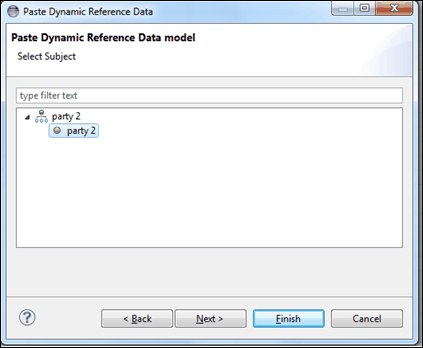
If Reference Data was copied from a project that contains Source Systems, then the last screen of the wizard will contain the above options and work the same way as pasting Static Reference Data.
Context Menu Options for Specific Reference Data Models
Right-clicking a Reference Data Model displays a context menu, as shown in the following image.
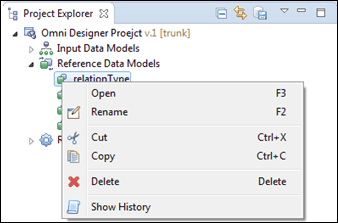
The following list describes each option in this context menu.
- Open. The Reference Data settings editor for static reference data model can be opened in the editor using the Open option from context menu, pressing F3, or by double-clicking the required reference data model.
- Rename. The Reference Data Model can be renamed in line
or by pressing F2. If you rename the Reference Data Model, then
the root subject will be also renamed to the same name.
To rename the item you wish, select the Rename option, enter a new name of the item, and press Enter.
- Cut. The Cut option copies and deletes the Reference
Data Model and simultaneously moves them to the Clipboard.
You can also press Ctrl+X or select the corresponding option from the Eclipse menu.
- Copy. The Copy option copies the Reference Data Model.
You can also press Ctrl+C or select the corresponding option from the Eclipse menu.
- Delete. The Delete option deletes the subject(s) from
the project.
You can also press the Delete key or select the corresponding option from the Eclipse menu.
- Show History. Functions the same way that was mentioned in the context menu for a shared Omni Designer project. The Show History option is available only if the project is shared.
Context Menu Options for Multiple Selected Nodes
A context menu appears for the same and different Omni Designer Project Explorer items selected together (using Shift or Ctrl keyboard keys). Standard options for selected items are available in the menu. Options that can be applied to all selected items simultaneously are enabled in the context menu (for example, Delete).
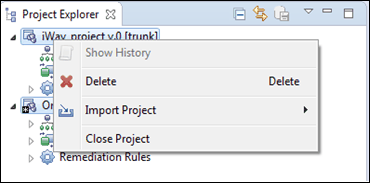
Options that cannot be applied to all, are disabled (for example, Rename, Show History, and so on).

Cutting, Copying, and Pasting for Multiple Selected Subjects
The Cut and Copy options are not available for two or more selected subjects. You can use the Copy Single Element option for several selected subjects to copy them or drag and drop the subjects to move them. Note that nodes move together with their children elements, but the Copy Single Element option copies elements without any child subjects.